Sony FE 70-200 f/4 G OSS Lens Review – Part 1
Introduction
Sony FE 70-200 f/4 G OSS is a full frame standard tele-zoom lens made for Sony E-mount cameras. It is a longest lens in a so called holly trinity – zoom lenses which covers FL from 16-200mm (usually 16-35, 24-70 and 70-200) that most professional photographers relies on. Sony introduced first Sony Vario-Tessar T* FE 24-70 f/4 ZA OSS, lens that has that famous Zeiss “Z” on the body. I haven’t buy that lens, nor I plan to do, but according to the reviews, it is not without flaws, especially in the corners. On the other hand, I have seen many “real life” images, which were mostly nice and crisp and I certainly haven’t seen significant corner smearing. The only drawback of that lens in my opinion is rather high price. But that’s Sony…
There is one more thing to consider. When Sony introduced their first NEX cameras in June 2010, their main selling point was a large sensor in a small body. By taking off the mirror, Sony was able to design camera with a sensor of the same size as it was in many DSLRs that time, but in a much smaller package. Moving lenses closer to the sensor, allowed Sony to make them smaller too, and they indeed started with SEL 16/2.8 pancake lens, which made DSLR IQ system possible to carry in the pocket.
But since today, Sony haven’t released anything longer than 200mm (210 actually) for the E-mount. There is a good reason for that though… While short flange distance (distance between lens mounting flange and sensor plane) allow smaller lens design up to approx. 50mm. Lenses with longer FL won’t benefit much from a shorter flange distance and in a result they have to be almost as big as their DSLR equivalents. Understanding this, we should also understand why there are not many E mount lenses longer than 50mm and those there are, are usually quite big.
What Sony probably didn’t expect, is the number of experienced enthusiast and even professional photographers, who were attracted by the mirror-less concept. Once the whole show started, Sony realized that there might be space for bigger but professional grade lens, and by introducing full frame E mount cameras, that becomes even more clear.
So after already mentioned Zeiss standard zoom – FE 24-70 f/4 OSS ZA, we have FE 70-200 f/4 OSS with a Sony professional designation – label G. Let’s see, if this lens rightfully belongs to the G family…
First Impression
Price is not friendly, especially for early adopters. In the time of this review writing, lens cost just bellow 1500 USD, but I had to pay for mine, even more in Europe – 1399 EUR (above 1800 USD). In comparison, mighty Canon EF 70-200 f/4 L IS USM, cost recently 1020 EUR (something above 1300 USD) and relatively new Nikkor AF-S 70-200 f/4 ED VR costs 1099 EUR (approx. 1420 USD). That makes Sony in Europe significantly more expensive than closest competitors and the fact that tripod ring is included in the package, can hardly help.
You’d expect thus to get something really special for the price, and the build quality doesn’t disappoint for sure, but it also doesn’t pull far away, from already mentioned Canon or Nikkor.
On the specification sheet though, we can read that lens features some of the most advanced recent technologies:
Advanced Aspherical element – quite hard to produce (according to Sony) due to the high requirements on precision of molded process. This element should significantly improve spherical aberration, delivering in a result crispier and higher contrast image. It also help keeping lens smaller with fewer glass elements.
Two ED elements, one being labeled as a Super ED, which on result should reduce chromatic aberration and improve sharpness and color rendition. Sony nano AR coating should help surpassing external and internal reflections.
Internal focusing, keeping front element steady, which makes usage of polarizer filters much easier e.g. Lens length stays intact with IR, and AF is supposed to be faster.
Circular 9 blades aperture, good for circular OOF highlights when lens is stopped down a bit.
OSS – optical steady shot, Sony name for optical stabilization. I can’t find how many extra stops it should allow for hand holding, but I would guess from experience – 3 to 4.
Finally there are also focus range limiter and focus hold button. First should allow for faster focusing at longer distances, while second should help to lock the focus in AF-C mode. (more about it in – handling)
Most of those technologies are rather small improvements in a real life, but some of them, especially aspherical and ED elements, as well as modern coatings, really improve resulting images. (If well designed and applied of course).
My first thought after taking the lens from the box was – what a light lens for its type! Looking at the specification, we can see that heaviest is Nikon at 850g, followed by Sony at 840g and the lightest is Canon at 750g. I had all of those lenses in my hand, and I find Sony to subjectively be the lightest one, even if figures says something else. It could be that Sony weight is with included tripod ring and hood, while Canon was weighted without both.
Lens is white and that should help to keep it cooler in the hot sunny days (in theory) but mainly, it should make its owner look more professional. I don’t like white lenses, but I got used to them and don’t really care anymore.
In the box you will find already mentioned tripod ring, protective bag and plastic, but very light – lens hood.
Handling
This is probably first Sony E mount lens, that features some professional lens controls, such as focus hold button, AF/MF switch on lens, OSS stabilization switch with separate 2 modes (hand held 1 and monopod 2) and surprisingly – focus limiter (full range or 3m to infinity). With a minimum focus distance of only 1m, that can be useful addition for speeding up the AF at longer distances.
Tripod collar is smart design (you can put it on or off, without taking lens from camera), but it doesn’t have hard stop at landscape and portrait orientation which is surprisingly omitted by designers. That makes alignment of the lens a bit tricky, despite little printed dots for both positions that should help with the task.
Tripod mount foot is a bit short for my taste, but I usually don’t work with this light lenses, so it could be just fine.
Lens hood is plastic but well made and I don’t really see the reason to have metal hoods as some lenses features. It fits quite well (there are red dot and line for alignment) and locks in a 90° twist. There is very little wobbling when properly mounted. Lens cap has two handles on the top surface, so in theory it should be easy to mount or take off the cap with the hood on, but in practice, it needs a bit of effort. When the lens cap is on and you want to take off the hood to mount it in reverse, cap will most probably jump off though. When the hood is in reverse position, focus ring is covered and MF is not possible.
Focus hold button is welcomed feature for action photographers who are often using AF-C mode (continuous focusing). ILCE-7 and ILCE-7r cameras, needs firmware 1.02 for this function to be enabled and when using it, you might experience some inconsistence in EVF reported values against recorded one. To use this button, you should be in a AF-C mode and when you hold it, camera will lock the AF, until you release it. Imagine that you shot runner using AF-C and he runs behind the trees on his track. You’d like to keep focus on him, while the camera in AF-C will intend to refocus on the trees in front. That’s the moment when you press focus hold button, telling the camera to keep the focus where it was. You can of course use AF-lock on button to, but position of those buttons on the longer lens such as FE 70-200 f/4 OSS is much more convenient. In theory, those buttons should be programmable for some other functions, and I am quite surprised that Sony didn’t allow it. Maybe some future firmware releases or new camera models will allow it.
It is quite pleasing experience to shot with this lens on Sony A7/r/s cameras. While the lens look large and long (and it is to certain extent), due to its reasonable weight, system is well balanced, at least much better than it might look.
What I hate however is a focus by wire. During my test in the last few months, I constantly had a problem to properly focus this lens, either using clumsy Sony A7 AF system, or more importantly, using manual focus. If you are looking for the critical sharpness at f/4, you might find (at least I did) a problem to achieve it with this lens. (more about it later)
Image quality
Testing the zoom lens is never easy. There are many images that needs to be taken, and many permutations that appears, if you want to create some valuable data in result.
Obligatory part of the review is some test chart. I am not using IMATEST generated MTFs, for many reasons, main being my skepticism toward reliability of data obtained that way by independent reviewers, and I don’t have optical bench to perform “pure” lens tests as I’d like to, but I will present you ISO 12333 chart that can be visually compared (and used for MTF results if you like too).
However, looking at the chart usually won’t tell you much, unless you can compare two images next to each other. For that reason, we are working hard to develop a module, that should allow our readers to select two lenses and/or cameras for direct comparison. It is quite demanding proposition, so meanwhile I have to stick with a Photoshop created “static” compositions.
In this case, I decided to put against Sony, one of the best standard tele-zooms that I know – Canon EF 70-200 f/2.8 L IS USM II. It isn’t quite fair comparison, so rather treat Canon as a reference, I never expected Sony to rival it, and in a test chart shoot out, it certainly didn’t. But test chart results are often quite useless for the real life situations, especially when it comes to things like field curvature, flaring resistance and distortion. I hope that with few sample images, you will see what I mean…
To make this review more readable, I decided to split it to several parts. In this first part, we will take a look at lens performance at 70mm.
Here is comparison of the 100% crops of the center part against Canon EF 70-200 f/2.8 L IS USM II
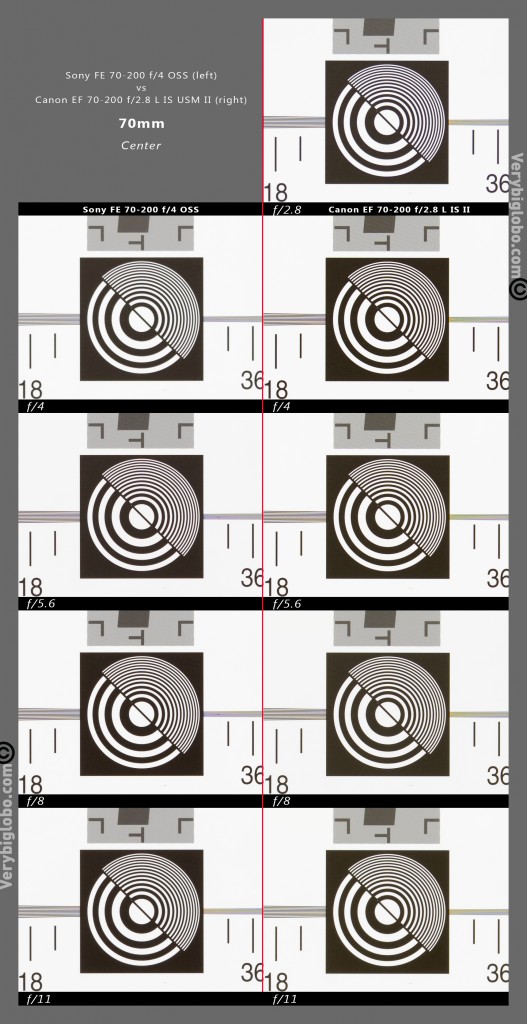
Sony FE 70-200 f/4 G OSS vs Canon EF 70-200 f/2.8 L IS USM II. Camera Sony A7. 100% crops from the center of ISO 12333 professional chart
In the center, Canon is sharper at f/2.8 than Sony at f/4 but at f/8 both lenses are almost indistinguishable. However, in the corners, Canon pulls apart in terms of corner resolution.
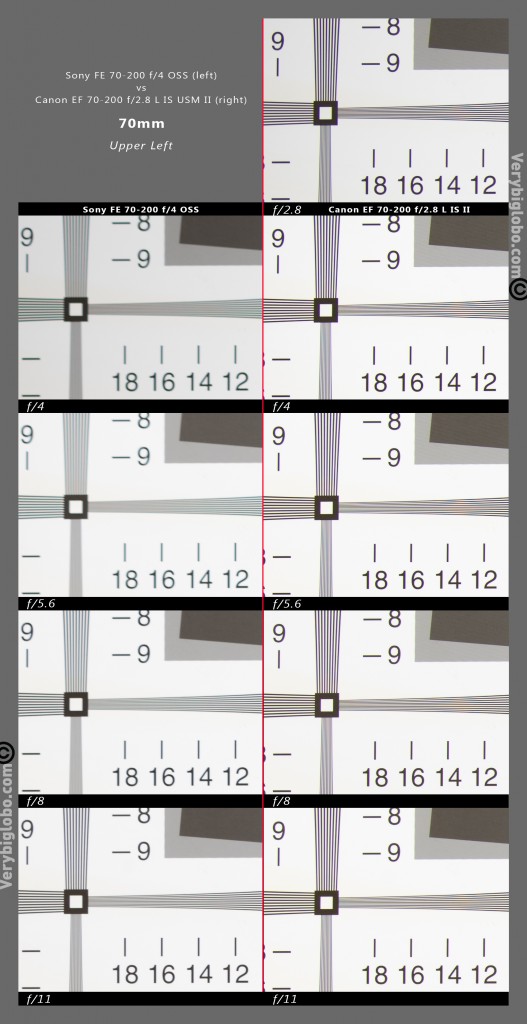
Sony FE 70-200 f/4 G OSS vs Canon EF 70-200 f/2.8 L IS USM II. Camera Sony A7. 100% crops from the upper left part of ISO 12333 professional chart
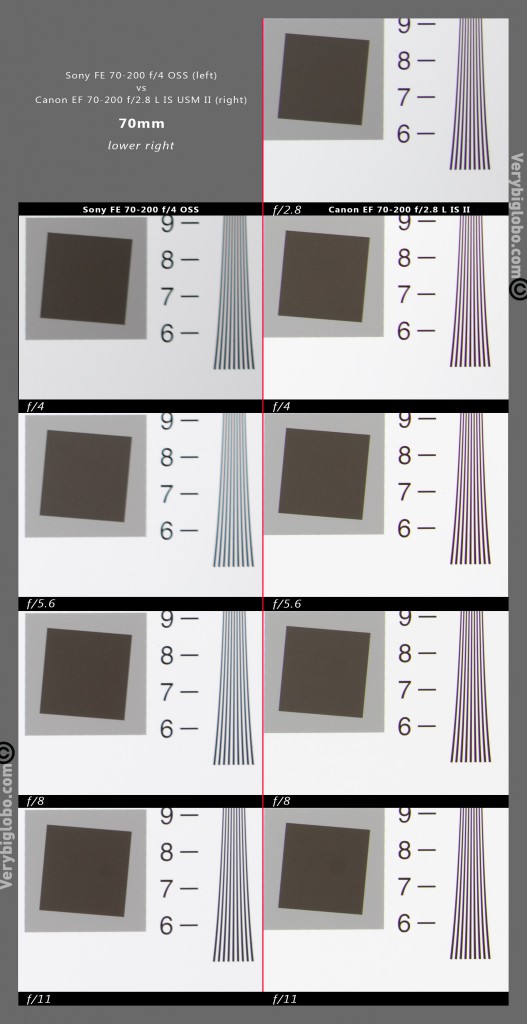
Sony FE 70-200 f/4 G OSS vs Canon EF 70-200 f/2.8 L IS USM II. Camera Sony A7. 100% crops from the lower right part of ISO 12333 professional chart
Results here would indicate pronounced field curvature with Sony FE lens, but also very good control of CA.
Before you fall into conclusion that Sony lens under-performed here, please take a look at following samples…
With increased distance from the subject, field curvature start to fade as a problem. Here is shot at some 2.5 meters from the flat wall at f/4.
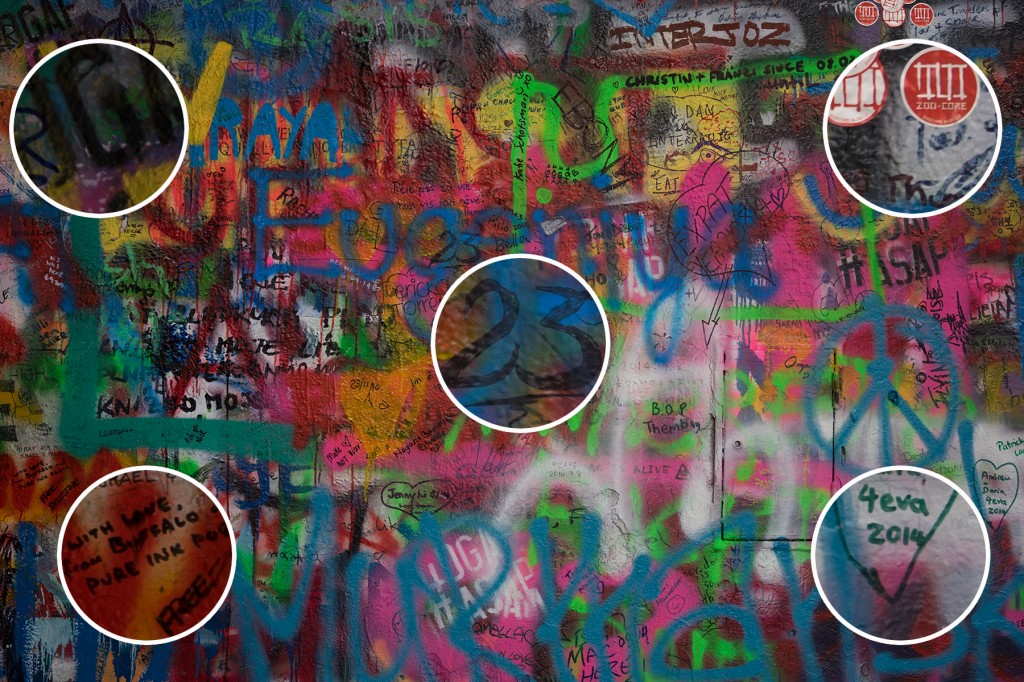
Sony FE 70-200 f/4 G OSS. Camera Sony A7. Flat subject is approx. 2.5m from the camera. In the circles you can see respective 100% crops at f/4
With increased distance from the subject, corners are already much better and by stopping lens further, you can expect – respectable results across the frame.

Sony FE 70-200 f/4 G OSS. Camera Sony A7. Flat subject is approx. 2.5m from the camera. In the circles you can see respective 100% crops at f/8
But moving even further from the subject shows even better improvement in terms of even performance across the frame and it also reveals already mentioned – effective control of chromatic aberrations.

Sony FE 70-200 f/4 G OSS. Camera Sony A7. Focus close to infinity. Above and bellow are respective 100% crops. No pp sharpening except standard settings in Lightroom 5.6
Finally, let’s take a brief look at distortion at 70mm.
There is very slight barrel distortion, but nothing that stands out.
As you can see from the samples above, Sony FE might not have greatest MTF figures, because charts are shot at close to minimum focus distances. With increased distance to the focus plane, relative DOF increases too and thus field curvature becomes less relevant. Of course with the different zoom settings, performance will vary too.
You can read second part of the review here – http://www.verybiglobo.com/sony-fe-70-200-f4-g-oss-lens-review-part-2/
Please help support this page and upcomming reviews and buy through affiliate links, with no extra cost for you:
Buy on BHPhoto: FE 70-200mm f/4.0 G OSS Lens
Buy on Amazon: FE 70-200mm f/4.0 G OSS Lens
To help this page survive, your donation will be highly appreciated.
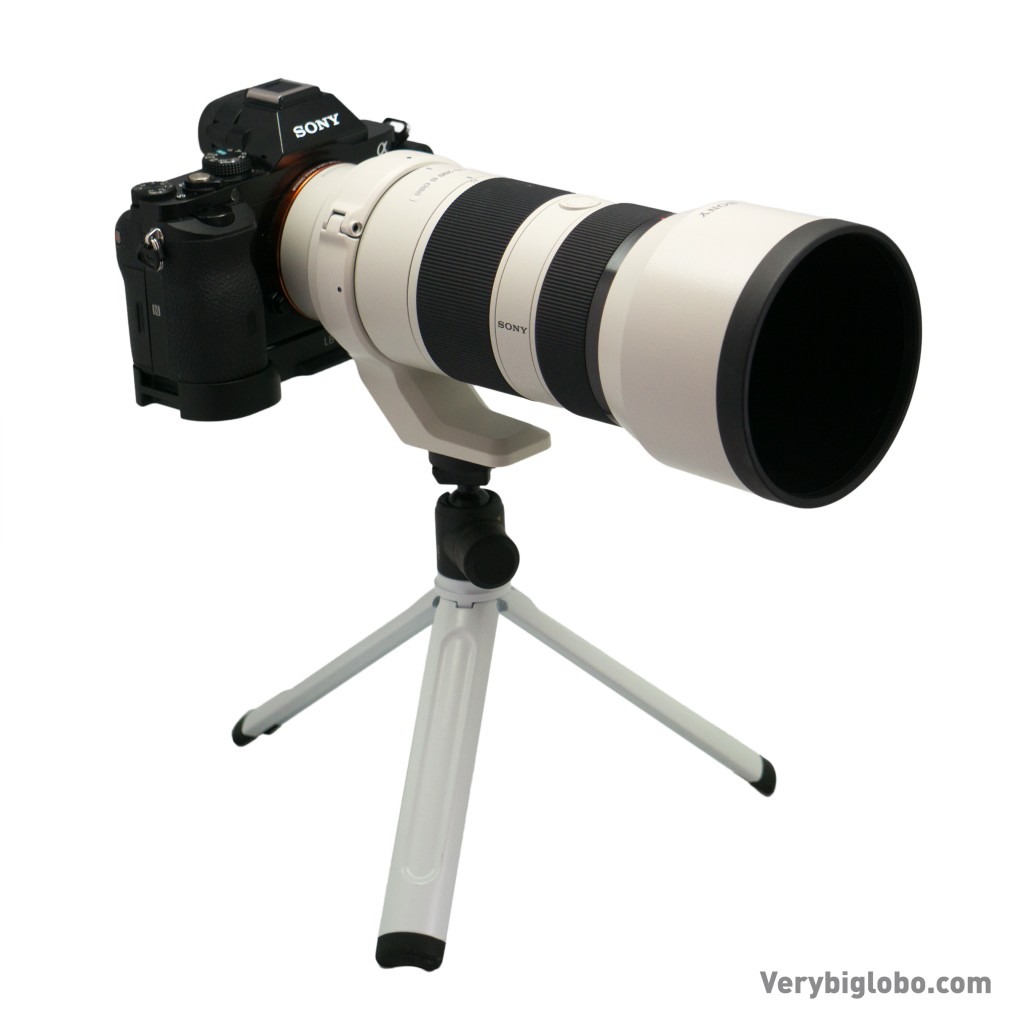
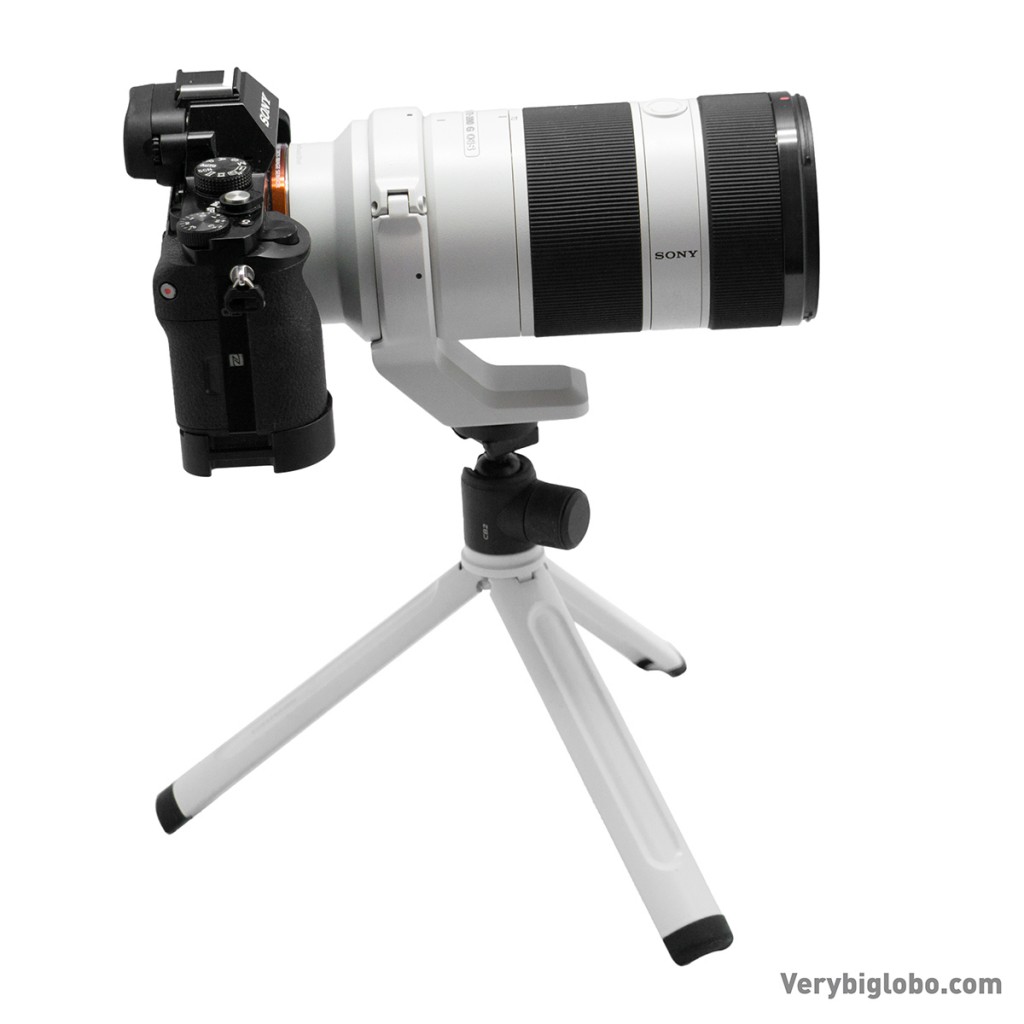
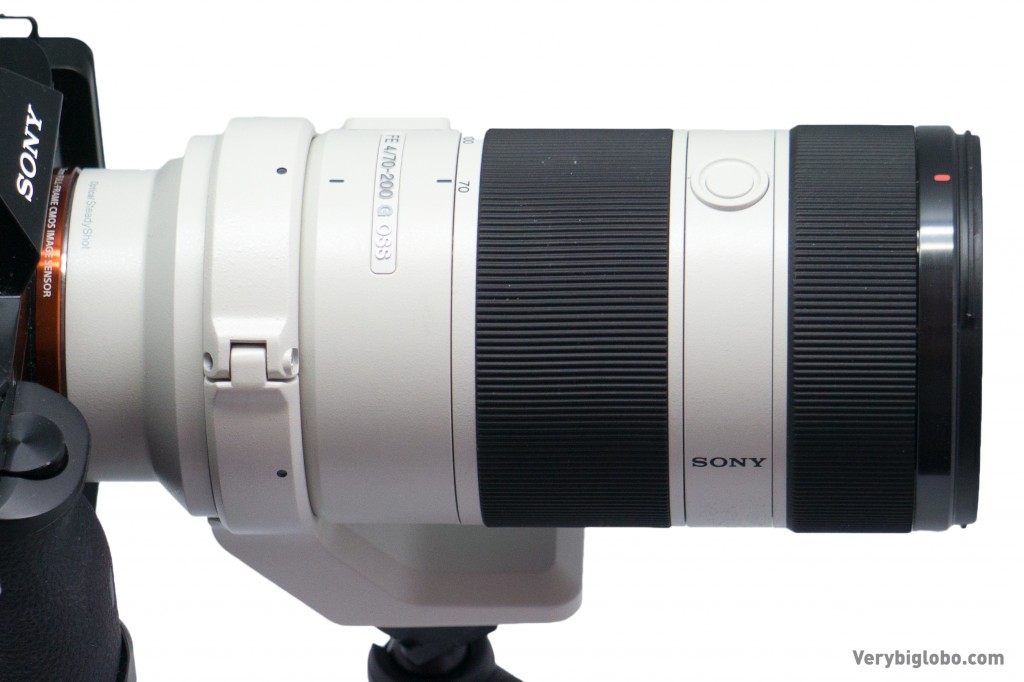
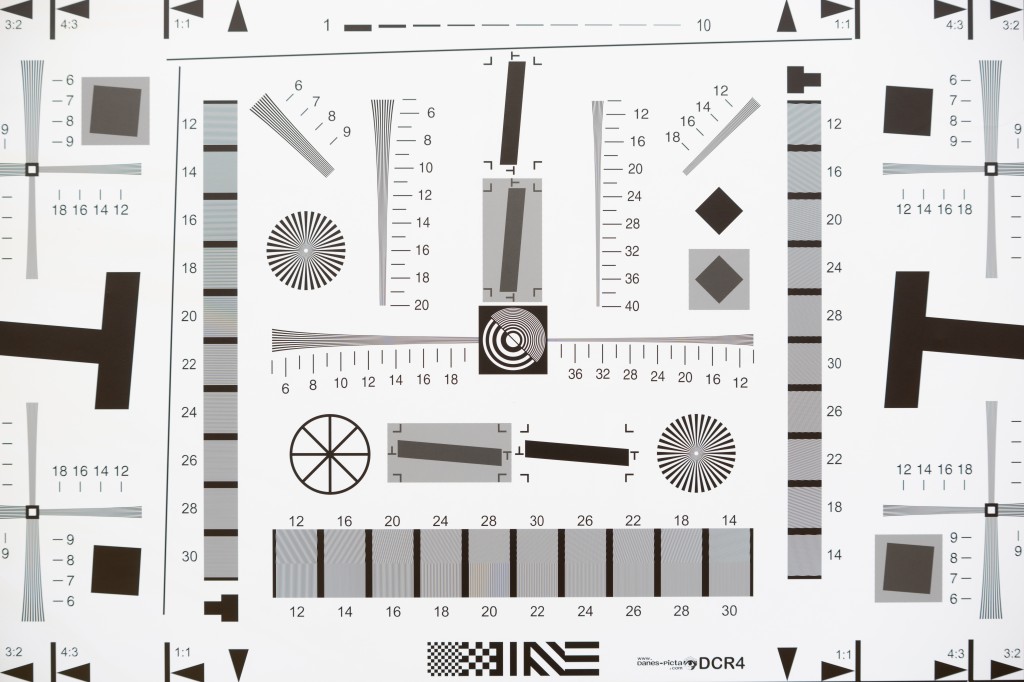

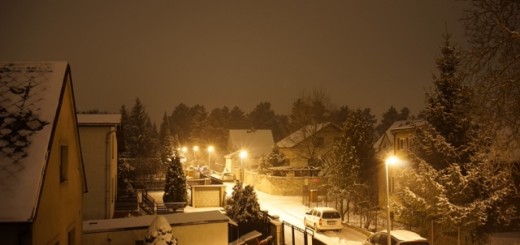
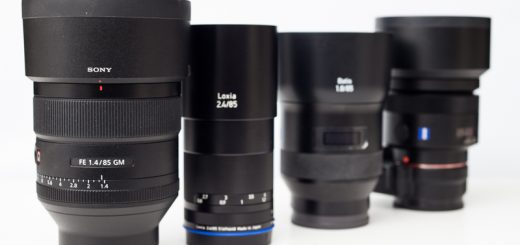













finally moved from blogspot! congrats 🙂
Thanks Dan. This engine will give us all more possibilities, tools and fun.
hi viktor, thanks for the review!
so it seems that you can rotate the tripod collar freely across 360 degrees? is there a hard stop for the default landscape position?
Hi al, there isn’t any hard stop, so it’s a bit annoying, but doable.
hello
if you can explain
i shot 2 photos on sony A6000, head shot
1 photo sel 70 200 f4 g lens, 200mm zoom and other with 55-210 sel 210mm zoom
head is on both frames same size, as i was reading,… if its fe lens it should be 300mm on apc senzor
so head should be more zoomed in or fill more frame
im confused, why in both frames head is same size
thank you very much if you could explain me this
Hi Robert,
I understand that you are confused, because it is indeed slightly strange, but the trick is that most lenses are “calibrated” in regard to 35mm format or as used to be called today – full frame.
Your SEL 55-210 indeed gives you 82-315mm FOV respectively and your FE 70-200 f/4 OSS gives you 105-300mm FOV equivalent.
In other words, lenses designed for smaller sensors, still have same nominated focal length as lenses designed for bigger or smaller sensors, because FL is property of the lens alone and has nothing to do with sensor behind.
Unlike FE 70-200 f/4 OSS, SEL 55-210 f/5.6-6.3 won’t cover full frame if mounted on Sony A7 (e.g.) camera though. (You will see hard black vignetting around edges on full frame).
Many people are confused because they expect that lenses designed for their APS-C (or MFT) cameras will have FL nomenclature related to respective sensor size, which is not the case. (Except some lenses for really small sensor sizes in smartphones or PS cameras)
On the other hand, if the FL will be adjusted for the sensor size (your SEL 55-210 will be named as SEL 85-315) I believe that even more confusion will be involved.
Just remember, that no matter for which system lens is designed , FL written on the lens is always valid in respect to 35mm format (full frame). If you keep using Sony A6000 and want to know to what FOV your lens will refer on that body, multiply FL by 1,5x as you already know and you will get an idea.
(There are some specifics related to tele zoom lenses, such as focus breathing, which might result in wider FOV than nominated FL should have, but that’s another story, and Sony FE 70-200 f/4 OSS doesn’t suffer from that phenomenon much.)
Therefore – this might be good and bad news for you at the same time. While you were probably expecting to get more reach with FE lens than you have with your SEL 55-210, which isn’t the case, with both lenses you already have equivalent of 300mm FL FOV.
If you need more, I can recommand Minolta 100-300 f/4.5-5.6 APO D lens with LA-EA2/4 which will give you FOV equivalent of 150-450mm lens. (there are better lenses of course, but this is good IQ/price option). Another option is to put teleextender on top of your SEL 55-210mm lens, such as Sony VCL-DH1758 e.g. You will need step-up ring, but its probably cheapest way how to get more reach prior to cropping.
Hope it helps,¨
Viktor
thanks you very much i was more looking samples and now i understand what you saying
i liked quality of sony fe 70-200 f4 so i bought it, is ti possible to put some extender or somehow make this fe 70-200 f4 longer, about flare is it possible to make it less with some filter
i have tokina 70-210 4-5,6 sdII but its hard to manual focus on flying bird, and its much softer than FE
ill try with Minolta 100-300 f/4.5-5.6 APO D
before i bought fe 70 200 f4 i was looking everywhere some review to compare SEL 55-210 vs FE 70 – 200 F4, if you ll have maybe time , interest to do it. I think there is lot of people buying sony e mount, and its all interchangeable so even if they are not in same quality class i think its very interesting, specialy for aps sensor buyers
I READ A LOT OF REVIEWS,…. BUT WHAT YOU ARE DOING IS REALLY BEST, CAUSE YOU SHOW WITH SPECS, CHARTS, AND AFTER REAL SHOOTING, AND ITS ALL CONNECTED
Hi Robert,
thank you for your support 🙂
It is possible to put tele-extender on Sony FE 70-200 f/4 OSS, but I never did it and can’t comment on resulting image quality.
Sony FE 70-200 f/4 OSS has 72mm diameter, so you will need to find something like this – http://www.ebay.com/itm/SIOCORE-72mm-1-8x-HD-Tele-Konverter-Tele-Vorsatz-Linse-fur-Canon-Sony-Panasonic-/381004806685?pt=DE_Foto_Camcorder_Vorsatzobjektive&hash=item58b5a7fa1d
For Sony SEL 55-210 f/5.6-6.3 which has 49mm front diameter, you might try already mentioned Sony VCL-DH1758 – http://www.ebay.com/itm/Sony-VCL-DH1758-Tele-Conversion-Lens-Kamera-Tele-Vorsatz-Linse-/261715552216?pt=DE_Foto_Camcorder_Vorsatzobjektive&hash=item3cef7667d8
with a step-up ring – 49-58mm – http://www.ebay.com/itm/Heliopan-Adapter-183-49mm-58mm-BRASS-Step-Up-Ring-MPN-700183-/371210776742?pt=US_Filter_Rings_Holders&hash=item566de2f0a6
Most other systems such as canon EF, Nikon F, Sony A etc. have also tele-converters that comes between the lens and camera.
Those usually gives much better quality than above listed tele-extenders that comes on front of the lens, but Sony doesn’t make any for E mount yet. Probably because this solution means loss of light, and their young AF system might have problems with it.
e.g. Canon EF 2x TC III tele converter, will make of 70-200mm f/2.8 zoom – 140-400mm zoom, but f/5.6, from the same f/4 zoom, you will end up with f/8 and that is fairly slow.
Above mentioned tele extenders doesn’t affect (in theory) light, so all lens functions could be used as usual, at the price of image quality loss.
I proposed Minolta 100-300 f/4.5-5.6 APO D because it can be found for very reasonable price and image quality is slightly above SEL 55-210.
If you want top BIF system, Sony E mount is probably not the best choice, but you can take a look at some professional Sony G lense (70-400 f/4-5.6 SSM II or Tamron SP 150-600 f/5-6.3 Di VC USD) for Sony A mount and one of the proposed adapters – Sony LA-EA2 or LE-EA4, that will give you quite fast phase detection AF. However, you should be prepared for high price and large and heavy combo.
Some people uses Bridge Super Zoom cameras such as Panasonic Lumix DMC – FZ1000 with great success, but I never tried one (I am rather manual focus guy).
I think I posted few comparison shots between SEL 55-210 and FE 70-200 f/4 G OSS in one part of my review, but I’ll have to take another look.
I will check about reported focal length on my A6000 when I get back home, but as far as I remember, you can see focal length in the playback mode, but not in the live view.
Thank you again for yours support, if you ever decide to buy anything from BH, Adorama or Amzaon, you can use any of our afiliate links (even for entirely different products) for your purchase. We will than obtain small amount from the vendor that will not cost you anything.
I hope this reply helps a bit and wish you lot of great shots,
Viktor
ah yes one more thing, i dont see on sony A6000 focal length, when i put sony fe 70 200 f4 or 55-210 sel
so ill have to remember for every photo what focal length it is, i send some very small donation
thank you for all info, i did put images on computer and there is written which zoom was used
could i just put Sony VCL-DH1758 with step down ring 72-58, is this too big difference and would be everywhere vignetting
Hi Robert, step down from 72 to 58 will vignette severely.
Cheers,
Viktor
Just ordered this lens. What brand table toptripod is that in the picture? Is it stable enough for this lens?
Hi Jazz1,
this is the tripod – http://www.bhphotovideo.com/c/product/799983-REG/Cullmann_CU_50081_Copter_Mini_Tripod_with.html (mine is in white color but it’s same thing)
It can hold the lens but not in too steep angles. Good as handy support in most situations though.
Cheers,
Viktor
Thanks to this review I will for sure not be buying the 70-200mm. I was having a hard time with the price for an F4 lens but at least I was expecting much better performance overall. To be beaten by the Canon when comparing them at F4 vs F2.8 was just too much. Edges also are too bad for my taste and money so I will keep waiting or keep adding legacy for now. 🙂
You write the best reviews on the net. I really like your mix of test charts, text and real world examples.
Thanks Ola, that’s very kind of you.
Cheers,
Viktor